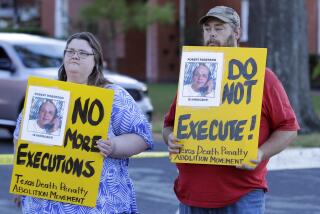EXECUTION JOURNAL : Lethal Gas or Injection--Harris Case Reignites Debate
SACRAMENTO — Until recently, the bulging manila folder marked “Lethal Injection” sat in Assemblyman Tom McClintock’s file cabinet, the focus of scant attention.
Rarely did McClintock’s staff consult the dogeared file--a 4-year-old record of the Thousand Oaks Republican’s failed fight to change the way California kills the condemned. Before Robert Alton Harris was scheduled to be put to death Tuesday, it had been years since anyone had asked to take a look.
But all that has changed. This week, Harris’ lawyers have taken a keen interest in the file, which contains the research McClintock used in 1987 when he proposed legislation to replace cyanide gas with a chemical-filled syringe.
On Thursday, as Gov. Pete Wilson denied Harris’ plea for clemency, there were signs that Harris’ defense team would file suit alleging that the gas chamber is an instrument of cruel and unusual punishment.
If they attempt such an 11th-hour lawsuit, the fraying bill file figures to be among the resources upon which they rely.
McClintock’s bill, which he claimed would install a “state-of-the-art” system that would make executions cheaper, quicker, more merciful--and less vulnerable to attack--was defeated in committee in 1988.
Opposed by civil rights advocates, who argued that no execution is humane, the bill also lacked crucial support from Department of Corrections officials. They feared that by raising questions about the humaneness of a gas chamber that had sat idle for two decades, the bill would fuel new legal challenges--much like the one Harris’ lawyers are expected to file today.
Corrections officials, McClintock said recently, “wanted to re-establish its (the gas chamber’s) use” before tackling the politically charged issue of whether gas is humane.
The bill failed, but the research upon which it was based was filed away, an odd compendium of macabre documents.
There is a copy of the execution procedure used in Texas--one of 20 states that uses lethal injection. There is a precise recipe for poison, and a list of inmates who died when it entered their veins.
There is a brief history of San Quentin’s gas chamber, which was installed in 1937, and an air quality study measuring concentrations of hydrogen cyanide downwind of the chamber’s exhaust system.
But most compelling are McClintock’s comments, gathered in typed news releases and handwritten notes, which attack the gas chamber as an outmoded “relic”--slow, ponderous and difficult to witness.
“When the prisoner resists death,” says one note in the file, “it can be hideous.”
A handwritten outline, apparently penned by a McClintock legislative aide under the heading “For Tom’s Statement,” laments the “carnival atmosphere” that surrounds executions at San Quentin.
“Lethal injection is different from lethal gas,” the notes say, “as you don’t see someone strangling to death in front of you. . . . We treat dogs better.”
There was a time, of course, when punishment was intended to be cruel and unusual. In 18th Century France--the era of gibbets and gallows, flogging and quartering--executions often included a lengthy series of unbearable sensations, inflicted in public, often in the center of town.
By design, these events were gory spectacles--frightening and messy. But soon, executions became more exacting, more technical, more swift.
The guillotine reduced death to what philosopher Michel Foucault calls “a visible, but instantaneous event. Contact between the law, or those who carry it out, and the body of the criminal, is reduced to a split second. There is no physical confrontation; the executioner need be no more than a meticulous watchmaker.”
Daniel B. Vasquez, warden at San Quentin, said the gas chamber over which he presides has similar advantages that make it far superior to lethal injection.
The chamber, he said, requires minimal contact with the condemned man--prison staffers strap him into a chair and “close a great big steel door.”
“Those physical barriers are also good emotional barriers,” he said. Lethal injections, by contrast, require prison personnel to touch inmates--sometimes even to grope for a vein.
“If I touch you, you and I become that much closer,” Vasquez said. “If I am going to ask my staff to carry out an execution, the last thing I want them to do is to somehow connect.”
McClintock, meanwhile, said that if Harris is executed Tuesday, he will reintroduce his lethal injection bill in the next legislative session. It is only a matter of time, he said, before California makes the switch.
More to Read
Sign up for Essential California
The most important California stories and recommendations in your inbox every morning.
You may occasionally receive promotional content from the Los Angeles Times.










